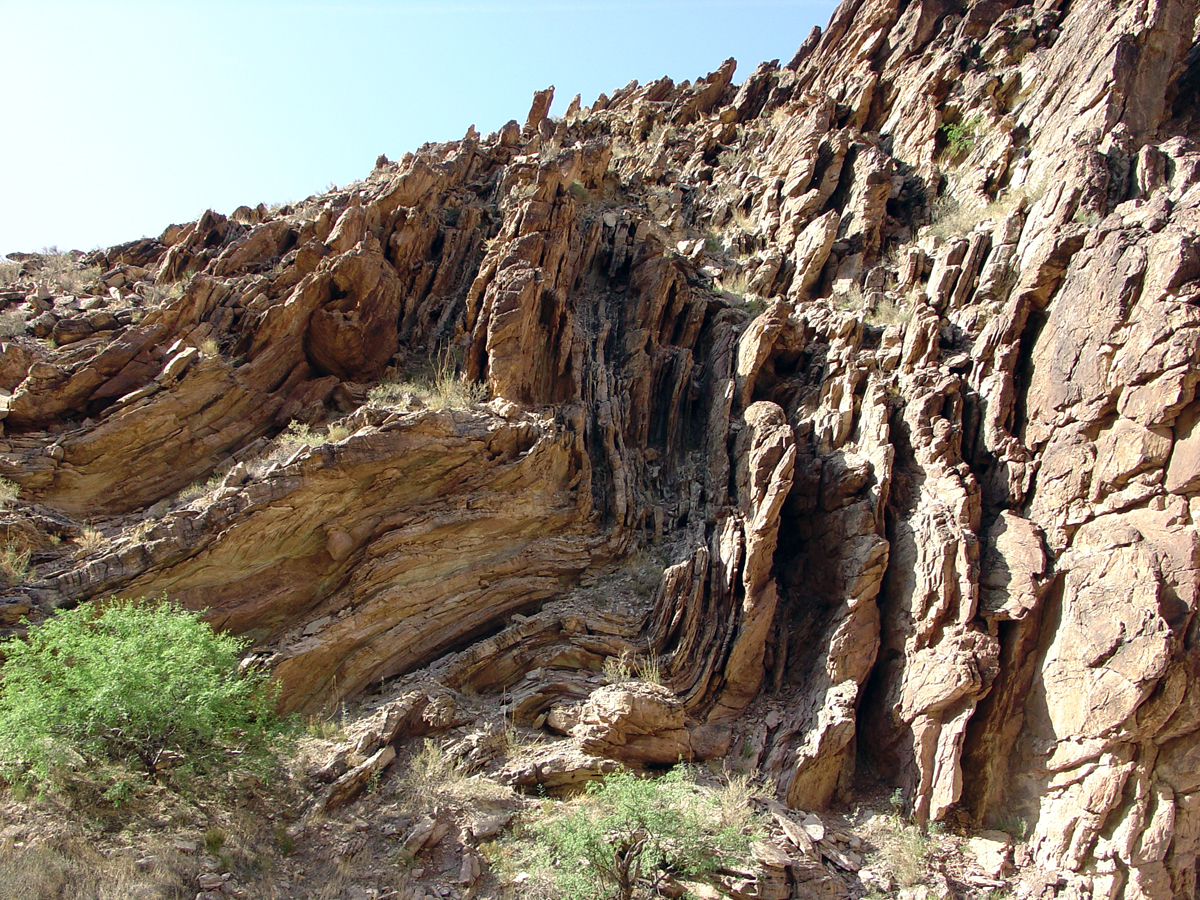
YEC Best Evidence 2: bent rock layers are not fractured — or are they?
Posted at 09:00 on 25 September 2017
Posts in this series:
The second of Answers in Genesis's ten best evidences for a young earth is the claim that in many mountainous areas, layers of sedimentary rock can be found that have folded and bent without fracturing. This, the argument goes, means that the layers in question must have deformed while they were still wet, and not long after they had solidified.
How does this prove that the earth is young?
It doesn't.
The first problem with this argument is that it places no constraint whatsoever on the age of the earth. Even if these layers were deformed as wet clay which had not yet hardened, no reason is given why this could not have happened 540 million years ago, as other evidence indicates, rather than during Noah's Flood.
Bent but not fractured — or are they?
The article illustrates its point with the following picture of some folded strata in Carbon Canyon, a side canyon off of the Grand Canyon:

(This rock formation appears to be on Google Maps here.)
Interestingly enough, the US Geological Survey has also published a photograph of exactly the same rock formation. Their photograph, taken in May 2007, looks like this:

When we compare the two versions, we see a massive difference in quality. The USGS version is in pin-sharp focus, well exposed, and published at a much higher resolution. (They even have a version viewable with 3-D glasses.) It also shows numerous clearly visible stress fractures, which are obscured in the AiG version by poor focusing and people in the photograph.
In a different article on the same subject, Andrew Snelling explicitly states that there are no fractures in the hinge of the fold. Yet if we look closely at the relevant part of the respective photographs, we see that fractures are clearly visible in the USGS version, whereas in the AiG version, there are people standing right in front of them:


What were these people doing there, one asks? Were they just there for scale? If so, why are they positioned exactly in front of the very fractures that contradict the entire argument?
The fact of the matter is that contrary to what Andrew Snelling claims, most bent rock layers are fractured, and as a PhD geologist, he should know this. In many cases, the fractures are only visible close up, and sometimes even only through a microscope, so the fact that they don't show up in a photograph — especially a badly-taken photograph — does not prove that they do not exist.
Brittle and ductile deformation.
The fact that these fractures exist directly contradicts the whole premise of this claim, as they indicate that the layers must have deformed after they had solidified, not before. But even if they didn't, it still would not prove that the layers were deformed before they had solidified.
Heat and pressure can make rock layers pliable. Snelling actually admits this, but dismisses it as a "rescuing device," claiming that the temperatures and pressures required would leave evidence of metamorphism in the rocks. He claims that this is not observed, but as he has stated that the rocks are not fractured despite publicly available evidence that they are, this claim is already suspect. In any case, he does not meaningfully cite any sources to back it up.
In order to demonstrate that ductile deformation is not a viable explanation, he needs to demonstrate that it requires higher temperatures and pressures than those that can cause metamorphism. These temperatures and pressures will vary from one mineral to the next, and have been well studied in laboratory experiments since the 1950s. Without such citations, this rejection of ductile deformation as a "rescuing device" is nothing more than a hand-wave, and should not be assumed to be reliable.
The gravity of the situation.
Another problem with this claim is that it ignores the law of gravity.
If these rock layers really had been deformed when wet, gravity would have pulled them downwards, and we would see considerable slumping, with the layers at the very least being much thicker at the bottom than at the top. We would certainly not expect to see vertical layers thirty metres or more in height retaining their structure, as we see in these photographs.
But in fact, if they had been deformed when wet, would we even expect them to be separated into distinct layers at all? This rock formation alone probably weighs somewhere in the region of a million tons, and at that scale, the layers would all end up being mixed together into one homogeneous mass. (See this article for a discussion — scroll down to the section headed "Orogeny.")
When I first saw the ten best arguments for a young earth, I thought this was one of the least convincing of the ten. Having seen the USGS photograph as well, it is certainly the one I found the most troubling. I don't want to accuse them of outright lying, but I struggle to see how it can be merely an honest mistake when a PhD geologist claims that a rock layer is not fractured when there is a publicly available photograph of it elsewhere clearly showing that it is, and his own out of focus photograph has students standing in front of the most prominent fractures that contradict him.
As a final twist in the tale, it turns out that this rock formation was also the subject of Andrew Snelling's discrimination lawsuit against the Grand Canyon National Park authorities, which was resolved this summer — and in fact, this very question is the subject of his proposed research. Ken Ham has a blog post giving further details of his study, which also includes some better quality pictures of the same rock formation.

In which the fractures are clearly visible.